- Accueil
- Pages cachées
- 26 AOUT 2023 NEWS
26 AOUT 2023 NEWS
INSTITUT SUPERIEUR D'ANTHROPOLOGIE
INSTITUTE OF ANTHROPOLOGY
ONLINE COURSES / COURS A DISTANCE
DEBUT COURS : SEPTEMBRE 2023
REGISTER NOW
MALAISIE – 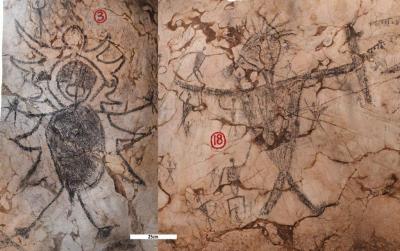 Gua Sireh cave complex - Researchers discovered that two anthropomorphic figures of indigenous warriors were created amid geopolitical tensions with the ruling class and other tribes in what is believed to be the first age study of Malaysian rock art. New radiocarbon dating of rock art in the Gua Sireh cave complex is helping shed light on a tumultuous period for the Indigenous Bidayuh people of the Sarawak region, in what is now Malaysian Borneo. Approximately 55 km southeast of Sarawak’s Capital, Kuching, the site is managed by the Bidayuh (local Indigenous peoples) in collaboration with The Sarawak Museum Department, with the drawings depicting Indigenous resistance to frontier violence in the 1600s and 1800s AD. While the Bidayuh did not keep a written record of their history, they were among the Indigenous peoples who adorned the cave walls of Gua Sireh and elsewhere with rock art, using simple pigments to produce various motifs and drawings, depicting more than 300 images. A team of Australian scientists recently used radiocarbon dating to complete the first chronometric age study of Malaysian rock art, as reported in an article published Wednesday in the journal PLOS One. The team of researchers focused on the two largest charcoal drawings in the cave complex. One, identified as GS3, is a round-bodied human-like figure, with accoutrements including a cloak, headdress and knives in each hand. The other, GS4, is described as a large anthropomorphic figure with an infilled triangular body holding a sheathed knife. New radiocarbon dating detailed in the article gives researchers a timeline for when the art was made: the GS3 figure was likely produced between 1670-1710 while the GS4 figure dates to 1800-1830. These findings allow researchers to place the drawings in historical context. “When the older anthropomorph was drawn, the Bidayuh were dominated by Malay elites, whereas the second large anthropomorph would have been made during a period of increasing conflict between Bidayuh and both Iban and Brunei Malay rulers,” the team said. “During this period many Indigenous Sarawakians moved into the upland interior, including the Gua Sireh area, to escape persecution.”
Gua Sireh cave complex - Researchers discovered that two anthropomorphic figures of indigenous warriors were created amid geopolitical tensions with the ruling class and other tribes in what is believed to be the first age study of Malaysian rock art. New radiocarbon dating of rock art in the Gua Sireh cave complex is helping shed light on a tumultuous period for the Indigenous Bidayuh people of the Sarawak region, in what is now Malaysian Borneo. Approximately 55 km southeast of Sarawak’s Capital, Kuching, the site is managed by the Bidayuh (local Indigenous peoples) in collaboration with The Sarawak Museum Department, with the drawings depicting Indigenous resistance to frontier violence in the 1600s and 1800s AD. While the Bidayuh did not keep a written record of their history, they were among the Indigenous peoples who adorned the cave walls of Gua Sireh and elsewhere with rock art, using simple pigments to produce various motifs and drawings, depicting more than 300 images. A team of Australian scientists recently used radiocarbon dating to complete the first chronometric age study of Malaysian rock art, as reported in an article published Wednesday in the journal PLOS One. The team of researchers focused on the two largest charcoal drawings in the cave complex. One, identified as GS3, is a round-bodied human-like figure, with accoutrements including a cloak, headdress and knives in each hand. The other, GS4, is described as a large anthropomorphic figure with an infilled triangular body holding a sheathed knife. New radiocarbon dating detailed in the article gives researchers a timeline for when the art was made: the GS3 figure was likely produced between 1670-1710 while the GS4 figure dates to 1800-1830. These findings allow researchers to place the drawings in historical context. “When the older anthropomorph was drawn, the Bidayuh were dominated by Malay elites, whereas the second large anthropomorph would have been made during a period of increasing conflict between Bidayuh and both Iban and Brunei Malay rulers,” the team said. “During this period many Indigenous Sarawakians moved into the upland interior, including the Gua Sireh area, to escape persecution.”
TURQUIE –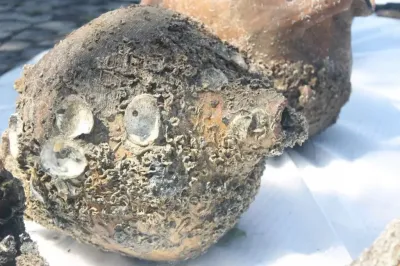 Yalova - A 1700-year-old shipwreck was discovered during maritime police training dives in the province of Yalova, located on the east coast of the Sea of Marmara, in northwest Turkey. In the Yalova, Phrygians in 1200 BC, In 700 BC years, the Bithynes became dominant. The region, which came under the rule of the Roman people in 74 BC. When Rome was divided into two in 395, Yalova remained within the borders of eastern Rome. The discovery was found about 200 meters from the shores of Yalova. The shipwreck was named ‘Yalova Gazi 1 Ship Wreck’. Under the coordination of the Ministry of Culture and Tourism, work carried out in the area revealed amphorae, called as such, extensively used in trade between the 9th and 13th centuries, along with wooden fragments and ballast stones. During the studies carried out in the area called Yalova Gazi 1 Shipwreck; In addition to amphorae used to store fish, oil, olives, and dry food at 10 different points under 12 meters of water, wooden pieces and ballast stones used in ships were also retrieved from the sea. It was stated that the amphorae were in the form of Ganos type 1 and were used extensively in trade between the 9th and 13th centuries AD. The historical artifacts unearthed from the Yalova Gazi 1 Shipwreck, which is considered to be 1,700 years old, were brought to the Yalova Police Marine Port Branch Office. Gökhan Çağlardere, Yalova Police Marine Port Branch Manager, stated that they had come across various objects during training dives before, they found the remains of an ancient harbor and pier, and archaeological studies were carried out there.
Yalova - A 1700-year-old shipwreck was discovered during maritime police training dives in the province of Yalova, located on the east coast of the Sea of Marmara, in northwest Turkey. In the Yalova, Phrygians in 1200 BC, In 700 BC years, the Bithynes became dominant. The region, which came under the rule of the Roman people in 74 BC. When Rome was divided into two in 395, Yalova remained within the borders of eastern Rome. The discovery was found about 200 meters from the shores of Yalova. The shipwreck was named ‘Yalova Gazi 1 Ship Wreck’. Under the coordination of the Ministry of Culture and Tourism, work carried out in the area revealed amphorae, called as such, extensively used in trade between the 9th and 13th centuries, along with wooden fragments and ballast stones. During the studies carried out in the area called Yalova Gazi 1 Shipwreck; In addition to amphorae used to store fish, oil, olives, and dry food at 10 different points under 12 meters of water, wooden pieces and ballast stones used in ships were also retrieved from the sea. It was stated that the amphorae were in the form of Ganos type 1 and were used extensively in trade between the 9th and 13th centuries AD. The historical artifacts unearthed from the Yalova Gazi 1 Shipwreck, which is considered to be 1,700 years old, were brought to the Yalova Police Marine Port Branch Office. Gökhan Çağlardere, Yalova Police Marine Port Branch Manager, stated that they had come across various objects during training dives before, they found the remains of an ancient harbor and pier, and archaeological studies were carried out there.
https://arkeonews.net/on-the-eastern-shore-of-the-marmara-sea-off-the-coast-of-yalova-a-1700-year-old-shipwreck-was-discovered/
ITALIE – 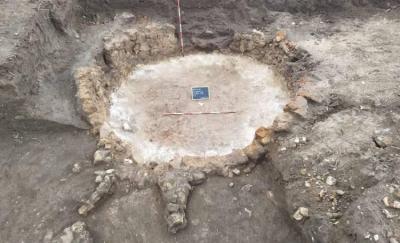 Nola - On the outskirts of Nola, a district from the early Middle Ages has been discovered. According to the Soprintendenza Archeologia, Belle Arti e Paesaggio for the Naples metropolitan area, the discovery of burials from the sixth and seventh centuries may have completely changed the course of Nola’s early Middle Ages. Nola was one of the most ancient cities of Campania, variously said to have been founded by the Ausones, the Chalcidians and the Etruscans. Its territory was very fertile, and this was the principal source of its wealth. The Etruscans were certainly in Nola about 560 BC when it sent assistance to Neapolis against the Roman invasion (328 BC). The Romans conquered Nola in 343 BC, and it was thenceforth faithful to Rome. Between the 5th and 15th centuries, the site flourished as a center of regional trade and craft production, and being associated with Saint Paulinus and Saint Felix, Nola has always been a popular destination for Christian pilgrims who make offerings at the Basilica di San Paolo and the Cathedral of Nola. In the Nola area on the outskirts of Naples, archaeologists have identified an entire medieval neighborhood, and burials dating back to the 6th and 7th centuries. Numerous fragments of pottery have been found that would testify to the area’s frequentation up to the 12th-13th centuries, when a craft district was set up, with the planting of limestone for turning architectural elements and sculptures composed of marble and limestone into lime. A statue of a togatus from the Roman period was found, missing its head, broken in two in the middle, but reconstructible. Due to their compatibility with various stone and metal surfaces, materials based on lime were highly valued by medieval artisans. Lime mortar was a useful material for maintaining and restoring older Roman statues and sculptures because it allowed for both structural support and aesthetic restoration. Medieval lime workers at Nola were skilled at mixing various lime mortars according to the task at hand and carefully repairing damaged statues. Medieval artisans frequently added substances to lime to change its consistency; for instance, pozzolana (a volcanic material) produced a thick lime paste that was spread and molded onto damaged marble statues.The discovery occurred during preventive investigations in the area of building construction and could be useful in reconstructing the history of the city founded in the 8th century BC.
Nola - On the outskirts of Nola, a district from the early Middle Ages has been discovered. According to the Soprintendenza Archeologia, Belle Arti e Paesaggio for the Naples metropolitan area, the discovery of burials from the sixth and seventh centuries may have completely changed the course of Nola’s early Middle Ages. Nola was one of the most ancient cities of Campania, variously said to have been founded by the Ausones, the Chalcidians and the Etruscans. Its territory was very fertile, and this was the principal source of its wealth. The Etruscans were certainly in Nola about 560 BC when it sent assistance to Neapolis against the Roman invasion (328 BC). The Romans conquered Nola in 343 BC, and it was thenceforth faithful to Rome. Between the 5th and 15th centuries, the site flourished as a center of regional trade and craft production, and being associated with Saint Paulinus and Saint Felix, Nola has always been a popular destination for Christian pilgrims who make offerings at the Basilica di San Paolo and the Cathedral of Nola. In the Nola area on the outskirts of Naples, archaeologists have identified an entire medieval neighborhood, and burials dating back to the 6th and 7th centuries. Numerous fragments of pottery have been found that would testify to the area’s frequentation up to the 12th-13th centuries, when a craft district was set up, with the planting of limestone for turning architectural elements and sculptures composed of marble and limestone into lime. A statue of a togatus from the Roman period was found, missing its head, broken in two in the middle, but reconstructible. Due to their compatibility with various stone and metal surfaces, materials based on lime were highly valued by medieval artisans. Lime mortar was a useful material for maintaining and restoring older Roman statues and sculptures because it allowed for both structural support and aesthetic restoration. Medieval lime workers at Nola were skilled at mixing various lime mortars according to the task at hand and carefully repairing damaged statues. Medieval artisans frequently added substances to lime to change its consistency; for instance, pozzolana (a volcanic material) produced a thick lime paste that was spread and molded onto damaged marble statues.The discovery occurred during preventive investigations in the area of building construction and could be useful in reconstructing the history of the city founded in the 8th century BC.
TURQUIE – 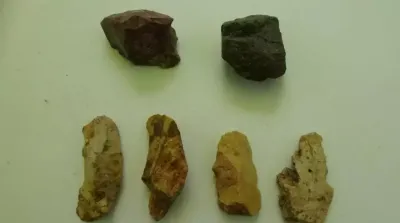 İnkaya Cave - In the excavations carried out in the İnkaya Cave in Çanakkale, located in the northwestern part of Türkiye, in addition to the traces of 86 thousand years of human life in the layers of the cave, many tools made of flint for various purposes were also found. Excavations in the cave, which will shed light on Paleolithic period migrations between Anatolia and the Balkans, were carried out by an international team between 2017 and 2020 under the presidency of the Troy Museum Directorate. During the excavations carried out last year, the Middle Paleolithic period workshop part of the cave was unearthed. “Our work in this area has taken us to the Middle Paleolithic Period, roughly dating back from 250,000 to about 50,000 years ago. Our findings indicate that people lived here intensely during this period.” The finds on the eastern slopes of the cave provide researchers with more precise information in terms of dating, taking them back to 86,000 years ago, Özer stressed. Noting that the remnants obtained during the excavation are currently limited to flint artifacts, Özer said that they have not yet found organic remnants, such as skeletal remains of the humans who lived in the cave during that period, animal bones or plant residues, which are the kitchen scraps humans consumed. “A toothed tool we found in the excavations could have been used for a purpose similar to today’s saw. As for the tools with handles, they might have been inserted into a tree branch or perhaps into bone or horn using resin, after thinning out the handle part of the tool. The edges would be worked on to make them functional. These tools could have been used for digging the soil or scraping the skin of animals. We will determine their specific purposes in the coming years through microscopic analysis of the stones,” he explained.
İnkaya Cave - In the excavations carried out in the İnkaya Cave in Çanakkale, located in the northwestern part of Türkiye, in addition to the traces of 86 thousand years of human life in the layers of the cave, many tools made of flint for various purposes were also found. Excavations in the cave, which will shed light on Paleolithic period migrations between Anatolia and the Balkans, were carried out by an international team between 2017 and 2020 under the presidency of the Troy Museum Directorate. During the excavations carried out last year, the Middle Paleolithic period workshop part of the cave was unearthed. “Our work in this area has taken us to the Middle Paleolithic Period, roughly dating back from 250,000 to about 50,000 years ago. Our findings indicate that people lived here intensely during this period.” The finds on the eastern slopes of the cave provide researchers with more precise information in terms of dating, taking them back to 86,000 years ago, Özer stressed. Noting that the remnants obtained during the excavation are currently limited to flint artifacts, Özer said that they have not yet found organic remnants, such as skeletal remains of the humans who lived in the cave during that period, animal bones or plant residues, which are the kitchen scraps humans consumed. “A toothed tool we found in the excavations could have been used for a purpose similar to today’s saw. As for the tools with handles, they might have been inserted into a tree branch or perhaps into bone or horn using resin, after thinning out the handle part of the tool. The edges would be worked on to make them functional. These tools could have been used for digging the soil or scraping the skin of animals. We will determine their specific purposes in the coming years through microscopic analysis of the stones,” he explained.
USA – 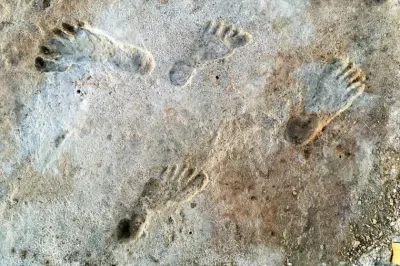 White Sands - Ice Age human footprints found at White Sands National Park in New Mexico are rewriting the history of humans in America. Scientists recently announced that the footprints are 23,000 years old, which means they are from the last Ice Age. The results have rekindled the question of how humans first arrived in the Americas. The footprints seem to suggest that these early travelers traveled across the continent when it predominately constituted of glaciers and ice. The study out of White Sands National Park, however, brings a different kind of evidence to the table—one that is less prone to error than artifacts and tools: namely footprints. Footprints were discovered by David Bustos, the resource program manager at White Sands National Park. He requested that a team of scientists analyze the prints. The team has found thousands of footprints throughout the eighty thousand acre park during their time working with Bustos. They have found footprints that show a mother resting her baby on the ground and others that were made by a person walking in a perfectly straight line for over a mile. Lastly, there were footprints that appear to have belonged to children.
White Sands - Ice Age human footprints found at White Sands National Park in New Mexico are rewriting the history of humans in America. Scientists recently announced that the footprints are 23,000 years old, which means they are from the last Ice Age. The results have rekindled the question of how humans first arrived in the Americas. The footprints seem to suggest that these early travelers traveled across the continent when it predominately constituted of glaciers and ice. The study out of White Sands National Park, however, brings a different kind of evidence to the table—one that is less prone to error than artifacts and tools: namely footprints. Footprints were discovered by David Bustos, the resource program manager at White Sands National Park. He requested that a team of scientists analyze the prints. The team has found thousands of footprints throughout the eighty thousand acre park during their time working with Bustos. They have found footprints that show a mother resting her baby on the ground and others that were made by a person walking in a perfectly straight line for over a mile. Lastly, there were footprints that appear to have belonged to children.
VIDEO = https://www.youtube.com/watch?v=dFk7o6C2kV8&t=362s
https://greekreporter.com/2023/08/22/ice-age-footprints-white-sands/
JAPON -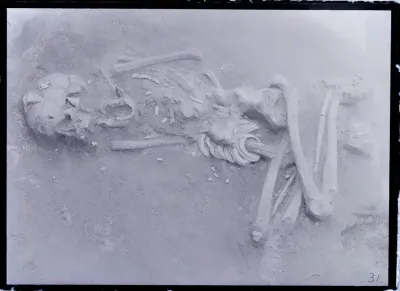
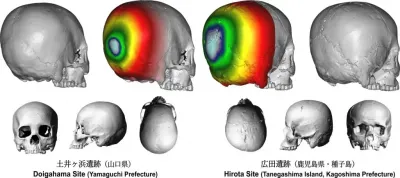 Tanegashima - A team of researchers from Kyushu University and the University of Montana has found evidence suggesting that the Hirota community, residing on Tanegashima Island in southern Japan from the late Yayoi era to the Kofun era (3rd to 7th century CE), practiced cranial modification. Researchers have unveiled new insights into the ancient practice of intentional cranial modification. This phenomenon, observed in various ancient civilizations globally, was also found among the Hirota people. These inhabitants of Tanegashima, a southern Japanese island, practiced cranial modification between the 3rd and 7th centuries CE, according to a report recently published in PLOS ONE. Interestingly, the research shows no notable differences between the genders, suggesting that both men and women engaged in this practice. Cranial modification is a form of body alteration where the head of a person is pressed or bound, usually at an early age, to permanently deform the skull. The practice predates written history, and researchers theorize that it was performed to signify group affiliation or demonstrate social status. “One location in Japan that has long been associated with cranial deformation is the Hirota site on the Japanese island of Tanegashima, in Kagoshima Prefecture. This is a large-scale burial site of the Hirota people who lived there during the end of the Yayoi Period, around the 3rd century CE, to the Kofun Period, between the 5th and 7th century CE.” explains Noriko Seguchi of Kyushu University’s Faculty of Social and Cultural Studies who led the study. “This site was excavated from 1957 to 1959 and again from 2005 to 2006. From the initial excavation, we found remains with cranial deformations characterized by a short head and a flattened back of the skull, specifically the occipital bone and posterior parts of the parietal bones.” The researchers used 3D images of skulls excavated from the Hirota site and the Doigahama site to compare skull morphology between the two groups. Notice that the skull from the Hirota site (right) has a more flattened back of the head compared to the skulls from the Doigahama site (left) indicating intentional cranial modification.
Tanegashima - A team of researchers from Kyushu University and the University of Montana has found evidence suggesting that the Hirota community, residing on Tanegashima Island in southern Japan from the late Yayoi era to the Kofun era (3rd to 7th century CE), practiced cranial modification. Researchers have unveiled new insights into the ancient practice of intentional cranial modification. This phenomenon, observed in various ancient civilizations globally, was also found among the Hirota people. These inhabitants of Tanegashima, a southern Japanese island, practiced cranial modification between the 3rd and 7th centuries CE, according to a report recently published in PLOS ONE. Interestingly, the research shows no notable differences between the genders, suggesting that both men and women engaged in this practice. Cranial modification is a form of body alteration where the head of a person is pressed or bound, usually at an early age, to permanently deform the skull. The practice predates written history, and researchers theorize that it was performed to signify group affiliation or demonstrate social status. “One location in Japan that has long been associated with cranial deformation is the Hirota site on the Japanese island of Tanegashima, in Kagoshima Prefecture. This is a large-scale burial site of the Hirota people who lived there during the end of the Yayoi Period, around the 3rd century CE, to the Kofun Period, between the 5th and 7th century CE.” explains Noriko Seguchi of Kyushu University’s Faculty of Social and Cultural Studies who led the study. “This site was excavated from 1957 to 1959 and again from 2005 to 2006. From the initial excavation, we found remains with cranial deformations characterized by a short head and a flattened back of the skull, specifically the occipital bone and posterior parts of the parietal bones.” The researchers used 3D images of skulls excavated from the Hirota site and the Doigahama site to compare skull morphology between the two groups. Notice that the skull from the Hirota site (right) has a more flattened back of the head compared to the skulls from the Doigahama site (left) indicating intentional cranial modification.
https://arkeonews.net/japans-ancient-practice-of-cranial-modification-hirota-people-in-tanegashima/
PEROU – 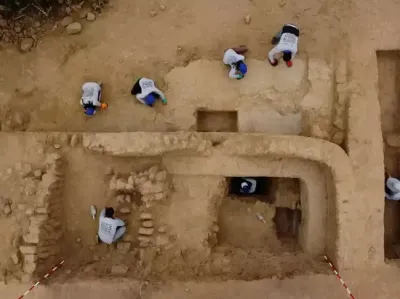 Viru Valley - An ancient polychrome wall discovered in northern Peru is believed to be over 4,000 years old and could have been part of a ceremonial temple, according to archaeologists, offering new insights into the region's historic cultures. The wall was first stumbled upon by farmers in 2020 during harvesting work, prompting an extended dig and work to determine its origins, said archaeologist Feren Castillo, head of a research project in the coastal region of La Libertad. "Three years later we started a new procedure whose results showed us its age ... Today we are sure it's a building built during the Pre-ceramic Period (the initial period of the Andean civilizations) between 4,000 and 4,500 years ago", the expert said this week", the expert said this week. The remains of the ancient building were revealed in the Viru Valley, some 480 km (298 miles) north of Lima. The wall is estimated to be about three meters (9.84 feet) high and presents triangular geometric lines with occasional shades of red and yellow, Castillo added. "The most important section ... must have been a pre-ceramic temple, with a hearth at its center that we will likely be able to excavate later," he said. The north of Peru is home to ancient ceremonial complexes such as Caral, which is about 5,000 years old; and to the mysterious, gigantic lines of Nazca, drawn in the desert more than 1,500 years ago, in ..
Viru Valley - An ancient polychrome wall discovered in northern Peru is believed to be over 4,000 years old and could have been part of a ceremonial temple, according to archaeologists, offering new insights into the region's historic cultures. The wall was first stumbled upon by farmers in 2020 during harvesting work, prompting an extended dig and work to determine its origins, said archaeologist Feren Castillo, head of a research project in the coastal region of La Libertad. "Three years later we started a new procedure whose results showed us its age ... Today we are sure it's a building built during the Pre-ceramic Period (the initial period of the Andean civilizations) between 4,000 and 4,500 years ago", the expert said this week", the expert said this week. The remains of the ancient building were revealed in the Viru Valley, some 480 km (298 miles) north of Lima. The wall is estimated to be about three meters (9.84 feet) high and presents triangular geometric lines with occasional shades of red and yellow, Castillo added. "The most important section ... must have been a pre-ceramic temple, with a hearth at its center that we will likely be able to excavate later," he said. The north of Peru is home to ancient ceremonial complexes such as Caral, which is about 5,000 years old; and to the mysterious, gigantic lines of Nazca, drawn in the desert more than 1,500 years ago, in ..
PORTUGAL –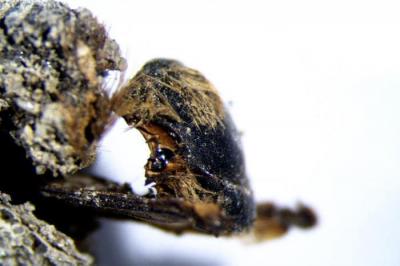 Odemira - Hundreds of mummified bees inside their cocoons have been found on the southwest coast of Portugal, in a new paleontological site on the coast of Odemira. The discovery published in the international scientific journal Papers in Paleontology states that this method of fossilization is extremely rare and normally the skeleton of these insects rapidly decomposes since it has a chitinous composition, which is an organic compound. About 2975 years ago, Pharaoh Siamun reigned in Lower Egypt; in China the Zhou Dynasty elapsed; Solomon was to succeed David on the throne of Israel; in the territory that is now Portugal, the tribes were heading towards the end of the Bronze Age. In particular, on the southwest coast of Portugal, where is now Odemira, something strange and rare had just happened: hundreds of bees died inside their cocoons and were preserved in the smallest anatomical detail. “The degree of preservation of these bees is so exceptional that we were able to identify not only the anatomical details that determine the type of bee, but also its sex and even the supply of monofloral pollen left by the mother when she built the cocoon”, says Carlos Neto de Carvalho, scientific coordinator of Geopark Naturtejo, a UNESCO Global Geopark, and collaborating researcher at Instituto Dom Luiz, at the Faculty of Sciences of the University of Lisbon – Ciências ULisboa (Portugal). Carlos Neto de Carvalho says that the project identified four paleontological sites with a high density of bee cocoon fossils, reaching thousands in a square measuring one meter. These sites were found between Vila Nova de Milfontes and Odeceixe, on the coast of Odemira, a municipality that gave strong support to the execution of this scientific study, allowing its dating by carbon 14. The cocoons now discovered, produced almost three thousand years ago, preserve as in a sarcophagus the young adults of the Eucera bee that never got to see the light of day. This is one of about 700 species of bees that still exist in mainland Portugal today. The newly discovered paleontological site shows the interior of the cocoons coated with an intricate thread produced by the mother and composed of an organic polymer. Inside, you can sometimes find what’s left of the monofloral pollen left by the mother, with which the larva would have fed in the first times of life. The use of microcomputed tomography allowed to have a perfect and three-dimensional image of the mummified bees inside sealed cocoons.
Odemira - Hundreds of mummified bees inside their cocoons have been found on the southwest coast of Portugal, in a new paleontological site on the coast of Odemira. The discovery published in the international scientific journal Papers in Paleontology states that this method of fossilization is extremely rare and normally the skeleton of these insects rapidly decomposes since it has a chitinous composition, which is an organic compound. About 2975 years ago, Pharaoh Siamun reigned in Lower Egypt; in China the Zhou Dynasty elapsed; Solomon was to succeed David on the throne of Israel; in the territory that is now Portugal, the tribes were heading towards the end of the Bronze Age. In particular, on the southwest coast of Portugal, where is now Odemira, something strange and rare had just happened: hundreds of bees died inside their cocoons and were preserved in the smallest anatomical detail. “The degree of preservation of these bees is so exceptional that we were able to identify not only the anatomical details that determine the type of bee, but also its sex and even the supply of monofloral pollen left by the mother when she built the cocoon”, says Carlos Neto de Carvalho, scientific coordinator of Geopark Naturtejo, a UNESCO Global Geopark, and collaborating researcher at Instituto Dom Luiz, at the Faculty of Sciences of the University of Lisbon – Ciências ULisboa (Portugal). Carlos Neto de Carvalho says that the project identified four paleontological sites with a high density of bee cocoon fossils, reaching thousands in a square measuring one meter. These sites were found between Vila Nova de Milfontes and Odeceixe, on the coast of Odemira, a municipality that gave strong support to the execution of this scientific study, allowing its dating by carbon 14. The cocoons now discovered, produced almost three thousand years ago, preserve as in a sarcophagus the young adults of the Eucera bee that never got to see the light of day. This is one of about 700 species of bees that still exist in mainland Portugal today. The newly discovered paleontological site shows the interior of the cocoons coated with an intricate thread produced by the mother and composed of an organic polymer. Inside, you can sometimes find what’s left of the monofloral pollen left by the mother, with which the larva would have fed in the first times of life. The use of microcomputed tomography allowed to have a perfect and three-dimensional image of the mummified bees inside sealed cocoons.
USA – Savannah - The sunken remnants of what is believed to be British warship HMS Rose, which met its fate 244 years ago in the waters off the coast of Georgia in America, have yielded a trove of historical artefacts including 19 cannons that remain loaded with ammunition. HMS Rose, a 20-gun Royal Navy ship, played a pivotal role in suppressing smuggling in the Rhode Island colony during the American Civil War, which is widely believed to have catalysed the formation of the Continental Navy, a precursor of the modern United States Navy. Recovery of the cannons began almost three years ago by the US Army Corps of Engineers after the wreck was discovered in Savannah Harbor in Georgia.The cannons were still loaded when they were hauled up from the ocean floor, sparking a race against time to protect and conserve these precious pieces of Royal Navy history. Archaeologists from Chronicle Heritage under contract to the US military sent 17 of the cannons to Texas A&M labs, a facility specialising in marine archaeological conservation, where work continues to restore them. The cannons are placed in a vat filled with sodium hydroxide as part of a process which pushes salts out of the metal and which can take a long time.
It could take up to two years to get all the salts out, according to Dr Dostal.




